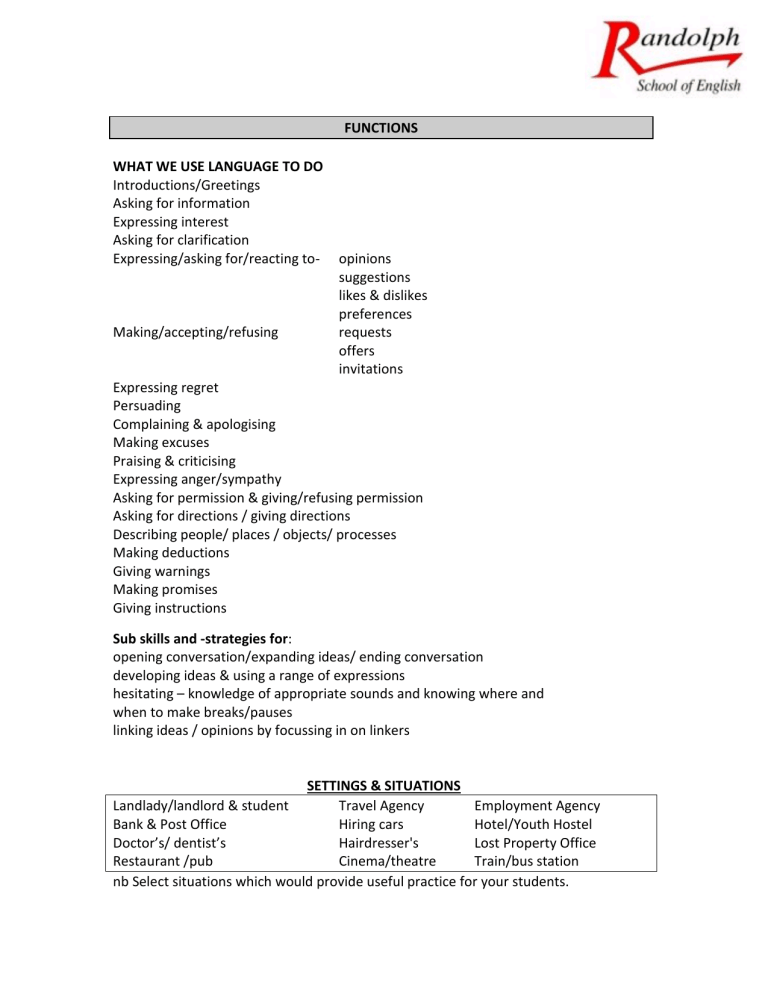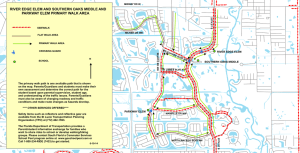
FUNCTIONS WHAT WE USE LANGUAGE TO DO Introductions/Greetings Asking for information Expressing interest Asking for clarification Expressing/asking for/reacting to- Making/accepting/refusing opinions suggestions likes & dislikes preferences requests offers invitations Expressing regret Persuading Complaining & apologising Making excuses Praising & criticising Expressing anger/sympathy Asking for permission & giving/refusing permission Asking for directions / giving directions Describing people/ places / objects/ processes Making deductions Giving warnings Making promises Giving instructions Sub skills and -strategies for: opening conversation/expanding ideas/ ending conversation developing ideas & using a range of expressions hesitating – knowledge of appropriate sounds and knowing where and when to make breaks/pauses linking ideas / opinions by focussing in on linkers SETTINGS & SITUATIONS Landlady/landlord & student Travel Agency Employment Agency Bank & Post Office Hiring cars Hotel/Youth Hostel Doctor’s/ dentist’s Hairdresser's Lost Property Office Restaurant /pub Cinema/theatre Train/bus station nb Select situations which would provide useful practice for your students. Points to remember: Select the functional area and the functional exponents. Remember that you are often building on existing language and extending their repertoire. Don’t overload -e.g. lower levels don’t need 10 ways to give advice. Your criteria is based on level, needs, usefulness, range Analyse the form ie the key structures. Highlight the language e.g. questions, affirmatives and negatives Anticipate problems with from and phonology. Remember that if you are doing a functional language presentation, this still needs to be drilled. Highlight the surrounding language –eg. (suggestion) –you might try + ing or a noun. Teach both sides of the conversation –e.g the apology and the response. Remember if introducing functional language, don’t overload with lots of new vocabulary. Highlight what’s appropriate ie-what would be the right response in that situation? Highlight formal versus informal language. Remember the language is affected by who (the speakers and their relationship); what (the task and what they have to do with the language) and where ( the setting) Look/listen out for what people say- collect data by noting the variations. Remember that the spoken form may differ from the written form. Incorporate phonology. You cannot teach functional language without addressing this. Remember, “It’s not what you say, but it’s the way that you say it.” MATERIALS Taboos and Issues Richard MacAndrew & Ron Martinez Communication Games Jill Hadfield (Nelson) Elem/Int/Adv Keep Talking F..Klippel (CUP) Beginners-Adv. First Impact P.Watcyn Jones (Penguin) Elem./Int. Functional Eng. Dialogues P.Watcyn Jones (Penguin Elem/L Int. Say What You Mean In English 1&2 Andrews Elem./Int. Survival English De Freitas Elem./Int. Situational Dialogues Ockenden Elem./ Int. Functions of English Jones (CUP) H.Int-Adv. Notions of English Jones (CUP) Upper.Int./Adv. Functional English 1& 2 White (Nelson) Int./Adv. Also use clips from the TV-chat shows, Newsnight, Youtube or tape friends (unscripted) CELTA Methodology Functional language Mary’s docs





